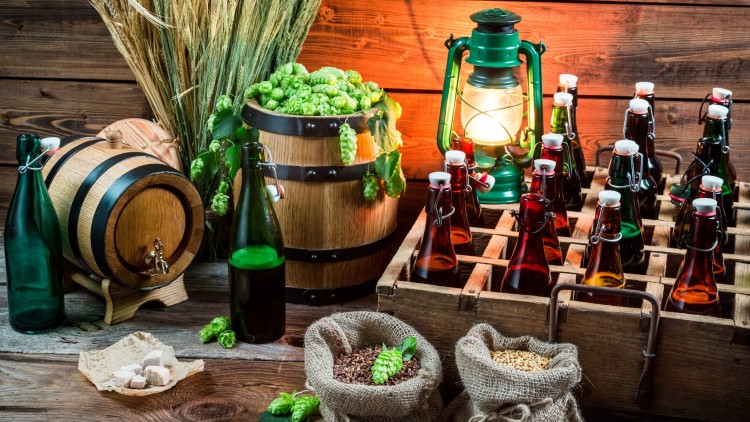
Are you ready to embark on an exciting journey into the world of homebrewing? If you’ve ever wondered how to make beer at home, you’re in the right place. Homebrewing isn’t just a hobby; it’s a craft that allows you to create unique, flavorful beers that suit your taste preferences. In this blog, we’ll walk you through the step-by-step process of brewing beer at home, from gathering the ingredients to savoring your homemade brew.
Before We Dive In: A Few Key Pointers
Before we get into the nitty-gritty of homebrewing, there are some essential points to keep in mind
- Patience is Key
Brewing beer takes time, and rushing through the process can lead to disappointing results. Be patient and enjoy the journey.
- Cleanliness is Crucial
Proper sanitation is vital in brewing to prevent contamination and off-flavors. Ensure all your equipment is thoroughly cleaned and sanitized.
- Experimentation is Encouraged
Once you’ve mastered the basics, don’t hesitate to get creative. Experiment with different ingredients and techniques to craft unique brews.
- Follow the Recipe
Especially if you’re a beginner, stick to a tried-and-true recipe. As you gain experience, you can start creating your beer recipes.
Now, let’s dive into the steps of how to make beer at home.
Step 1: Gather Your Equipment
Before you begin brewing, make sure you have all the necessary equipment. Here’s a list of the basics
- Brewing Kettle. A large pot for boiling your wort (unfermented beer).
- Fermentation Vessel.A container where your beer will ferment and mature.
- Used to allow gases to escape during fermentation while preventing contaminants from entering.
- To monitor the temperature of your wort.
- To measure the specific gravity of your wort and determine the alcohol content.
- Auto-Siphon.For transferring your beer between vessels.
- Bottles and Caps.For storing your finished beer.
- Sanitizing Solution.To ensure cleanliness and prevent contamination.
Step 2: Select Your Recipe
Once you have your equipment in place, it’s time to choose a recipe. You can find a wide variety of beer recipes online or in brewing books. As a beginner, it’s a good idea to start with a simple recipe like a Pale Ale or a Stout. Following a recipe ensures you have the right ingredients and instructions.
Step 3: Brew Day
On brew day, you’ll follow these key steps
- Sanitize Everything.Start by thoroughly cleaning and sanitizing all your equipment. This step is crucial to maintain a sterile brewing environment.
- If your recipe involves mashing, combine crushed grains with hot water to create a porridge-like mixture. This process extracts sugars from the grains.
- Boil the liquid extracted from the grains (wort) and add hops at various times to achieve desired flavors and aromas.
- After boiling, cool the wort rapidly using a wort chiller or an ice bath.
Step 4: Fermentation
Once your wort is cooled, it’s time for fermentation
- Transfer to Fermentation Vessel.Pour the cooled wort into your fermentation vessel.
- Add Yeast. Pitch your yeast into the vessel. Yeast will convert the sugars in the wort into alcohol and carbon dioxide.
- Seal with an Airlock.Attach an airlock to the vessel to allow gases to escape while preventing contaminants from entering.
Step 5: Bottling
After fermentation is complete, it’s time to bottle your beer
- Use an auto-siphon to transfer the beer from the fermentation vessel to bottles or kegs.
- Add Priming Sugar.If bottling, add priming sugar to the beer. This will carbonate the beer naturally.
- Cap or Seal.Seal the bottles with caps or keg your beer.
Step 6: Enjoy Your Beer
After allowing your beer to carbonate for a week or two, it’s ready to enjoy
- Chill your beer to your preferred serving temperature.
- Pour your homemade brew into a glass, savor the aroma, and take your first sip. Cheers to your brewing success!
Troubleshooting Common Issues
While brewing beer at home is a rewarding experience, it’s not without its challenges. Here are some common issues and how to address them
- Off-Flavors.Off-flavors can result from poor sanitation or yeast-related issues. Ensure cleanliness, and consider experimenting with different yeast strains.
- If you suspect an infection, it’s best to discard the batch to avoid potential health risks.
- Flat Beer.If your beer lacks carbonation, it may need more time to carbonate in the bottles or kegs.
- Cloudy Beer.Cloudiness can result from incomplete fermentation or inadequate chilling. Allow your beer to settle and clarify.
In Conclusion
Learning how to make beer at home is a fulfilling endeavor that allows you to craft unique and delicious brews. Whether you’re a novice or an experienced brewer, the process is a blend of science and art. Remember to follow the steps diligently, maintain cleanliness, and don’t be afraid to experiment. Brewing your beer opens up a world of possibilities, from creating your signature IPA to crafting the perfect stout. So, gather your equipment, select a recipe, and get ready to raise a glass to your brewing adventures!